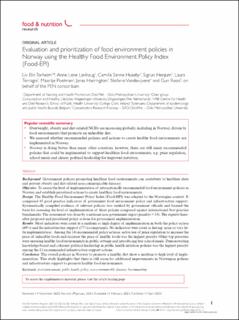| dc.contributor.author | Torheim, Liv Elin | |
| dc.contributor.author | Roos, Gun | |
| dc.contributor.author | Terragni, Laura | |
| dc.contributor.author | Huseby, Camilla Sanne | |
| dc.contributor.author | Løvhaug, Anne Lene | |
| dc.contributor.author | Harrington, Janas M. | |
| dc.contributor.author | Vandevijvere, Stefanie | |
| dc.contributor.author | Poelman, Maartje | |
| dc.contributor.author | Henjum, Sigrun | |
| dc.date.accessioned | 2023-07-11T09:03:43Z | |
| dc.date.available | 2023-07-11T09:03:43Z | |
| dc.date.created | 2023-04-18T09:11:25Z | |
| dc.date.issued | 2023 | |
| dc.identifier.issn | 1654-6628 | |
| dc.identifier.issn | 1654-661X | |
| dc.identifier.uri | https://hdl.handle.net/11250/3077564 | |
| dc.description.abstract | Background: Government policies promoting healthier food environments can contribute to healthier diets and prevent obesity and diet-related non-communicable diseases.
Objective: To assess the level of implementation of internationally recommended food environment policies in Norway and establish prioritised actions to create healthier food environments.
Design: The Healthy Food Environment Policy Index (Food-EPI) was adapted to the Norwegian context. It comprised 45 good practice indicators of government food environment policy and infrastructure support. Systematically compiled evidence of relevant policies was verified by government officials and formed the basis for assessing the level of implementation of these policies compared against international best practice benchmarks. The assessment was done by a national non-government expert panel (n = 35). The experts thereafter proposed and prioritized policy actions for government implementation.
Results: Most indicators were rated at a medium or high degree of implementation in both the policy action (69%) and the infrastructure support (77%) components. No indicators were rated as having ‘none or very little implementation’. Among the 14 recommended policy actions, active use of price regulation to increase the price of unhealthy foods and decrease the price of healthy foods was the highest priority. Other top priorities were ensuring healthy food environments in public settings and introducing free school meals. Demonstrating knowledge-based and coherent political leadership in public health nutrition policies was the highest priority among the 11 recommended infrastructure support actions.
Conclusion: The overall policies in Norway to promote a healthy diet show a medium to high level of implementation. This study highlights that there is still room for additional improvements in Norwegian policies and infrastructure support to promote healthy food environments. | en_US |
| dc.language.iso | eng | en_US |
| dc.publisher | Swedish Nutrition Foundation | en_US |
| dc.relation.ispartofseries | Food & Nutrition Research (FNR); | |
| dc.rights | Navngivelse 4.0 Internasjonal | * |
| dc.rights.uri | http://creativecommons.org/licenses/by/4.0/deed.no | * |
| dc.title | Evaluation and prioritization of food environment policies in Norway using the Healthy Food Environment Policy Index (Food-EPI) | en_US |
| dc.type | Peer reviewed | en_US |
| dc.type | Journal article | en_US |
| dc.description.version | publishedVersion | en_US |
| cristin.ispublished | true | |
| cristin.fulltext | original | |
| cristin.qualitycode | 1 | |
| dc.identifier.doi | https://doi.org/10.29219/fnr.v67.9117 | |
| dc.identifier.cristin | 2141478 | |
| dc.source.journal | Food & Nutrition Research (FNR) | en_US |
| dc.source.volume | 67 | en_US |

